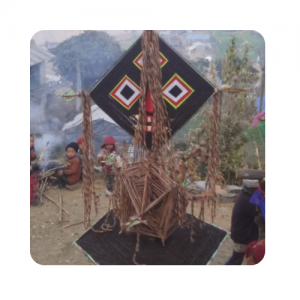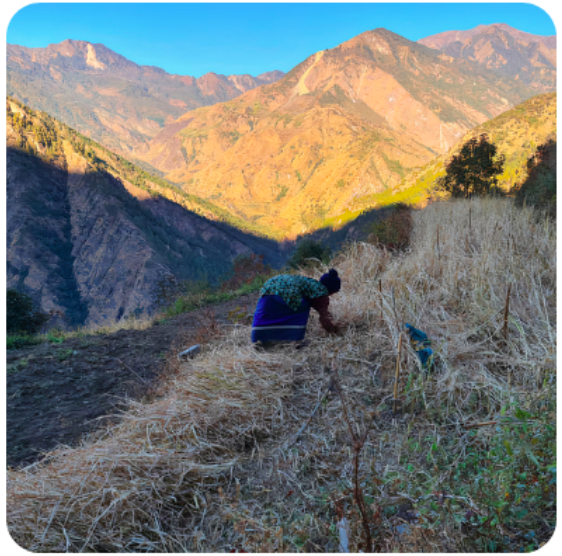Dominated by the Himalayan reliefs, the Ruby valley offers landscapes of a rare beauty. Named after the precious stone, as deposits are said to be found there, it is a mountainous region in central Nepal. It is a sparsely populated area with a population of approximately 11,000 people, and has a rich culture and ancient traditions that have been passed down from generation to generation. In 2021, Karuna-Shechen initiated development programs there for the first time (read more). It is the only NGO present in the region.
A population with diverse origins

The valley is inhabited by several ethnic groups: those from Tibetan migrations and those from Indian migrations. The latter, Dalits, Kamis and Gurungs, represent only a small part of the population of the valley. They are the descendants of the Tibetans who mainly populate the area. Among them, there are Tamangs, Ghales, and Newars.
The Tamangs, who are in a very large majority, are descended from nomadic Tibetan peoples. Although they have lost their mobility, the current residents of the valley have kept an important heritage from their ancestors.
First, with the language: Tamangs and Ghales speak Tamang, a Tibeto-Burmese language, and most of them do not understand Nepalese.

Then, with religion. While Hinduism is the majority belief in Nepal, it is not very present in the Ruby Valley. Indeed, the Tibetan origins of many of the locals make Buddhism the main religion of the region. Although there has been an increasing number of conversions to Christianity in recent years, the Buddhist heritage remains strong in most villages.
The valley even offers a unique religious and spiritual mix of Buddhism and shamanism, also inherited from Tibetan migrants. This is visible in the presence of many shamans, acting as doctors in most villages.
An ancestral tradition that celebrates life

In the Tamang culture, life is a gift and each person should be considered a god. Thus, many traditional festivals exist and celebrate the major stages of life. Khriti tyabpa to name a newborn, kyanwhaba to celebrate the first real meal, kshewar to celebrate the passage to adulthood or Jankhu to honor the longevity of the elderly: the ceremonies in honor of life are numerous. Those in honor of the deities are just as numerous. Dashain, Tihar, Sankranti… each of these festivals celebrates a god or a goddess and is the occasion for the locals to sing and dance with their relatives.

These dances and songs are an integral part of the culture of the valley. Named Tamang Selo, they are not only reserved for ceremonies. They accompany the populations in the acts of their everyday life. Specific to each action, they allow people to help each other in moments that can be trying. They can be found in particular during work on the land and with the animals – almost all the inhabitants of the valley are farmers or stockbreeders – as well as during long walks in the forest in search of wood.

This resource is indeed vital for the local communities, both for heating and for cooking, and all the members of the villages participate in its harvest, including the children. The children get up several times a week at around four o’clock in the morning to collect wood before going to school at eight. The women are also heavily involved in this task, carrying loads of over 80 kilos for several hours! Wood is also used to build houses, which are made of wood, stone and tin.
The manufacture of alcohol has a great importance in the local tradition. Distilled from locally grown products, it is used for celebrations and as an offering for marriage proposals. The offerings are made by the man’s family to the woman’s and their acceptance means a positive response.
A preserved territory, an isolated population
Alternating mountains – some of which are close to 4,000 meters in altitude – meadows, forests and lakes, the region presents a palette of scenery as varied as it is impressive.
This diversity of reliefs, sometimes extreme, makes the valley a particularly enclosed area. Although it is located in the province of Bagmati, like Kathmandu, access to the region is very complicated. Thus, to cover the 80 to 100 kilometers which separate the capital from the valley, it is sometimes necessary to count up to one day and half of travel.

This isolated existence from the rest of the country – if it has surely allowed to preserve some ancestral traditions and to protect its landscapes – is not without constraints. Indeed, such an isolation makes any access to infrastructures providing a quality education difficult. Although schools are present in the villages, many young people are forced to leave to receive a better education.
A similar problem is present for access to health care. The area is a real medical desert. Although most houses now have toilets and running water, which has improved the sanitary conditions of the region, the lack of health care is greatly felt. Especially at this time, every little bit of support counts.
